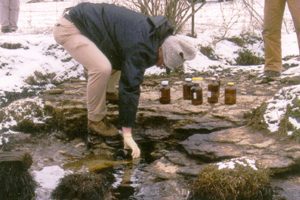
Presence Of Pesticides In Ground Water. Scientists at the U.S. Geological Survey (USGS)—in a study funded by the USGS National Water Quality Assessment Program (NAWQA)—investigated the presence of select pesticides and their degradation products in ground water. Degradation products are the chemicals that remain after a pesticide breaks down chemically. Groundwater—quite, simply water that comes from […]

Presence Of Pesticides In Ground Water. Scientists at the U.S. Geological Survey (USGS)—in a study funded by the USGS National Water Quality Assessment Program (NAWQA)—investigated the presence of select pesticides and their degradation products in ground water. Degradation products are the chemicals that remain after a pesticide breaks down chemically. Groundwater—quite, simply water that comes from the ground—is used as drinking water and to irrigate crops to grow the food we eat. As a matter-of-fact, one-half of all US drinking water comes from ground water.
The four sites selected for the study were located in Maryland, Nebraska, California, and Washington. All four locations chosen for the study are considered agricultural landscapes and were selected for “variability in overall land use, crops grown, climate, agricultural practices, irrigation, geohydrologic—the earth’s water—settings, and redox conditions.” Redox, or oxidation reduction, is the process in which one substance or molecule is reduced and another oxidized.
In the spring of 2004, and in the four research sites, researchers collected water samples from a network of 59 shallow single or clustered monitoring wells and analyzed the samples for the occurrence of 45 pesticides and 40 pesticide degradation products. The pesticide degradation products included herbicides, insecticides, and fungicides. Pesticides are those chemicals that kill insects, herbicides are those chemicals that kill weeds and unwanted plants, and fungicides are those chemicals that target and destroy plant diseases. Many studies conducted over the past four decades have long proven that pesticides—which are traditionally applied at the land surface—can, in fact, move downward to reach the earth’s water table at significant concentrations. Because of this, the chemicals can also contribute to ground water contamination. Once pesticides and their corresponding degradation products contaminate the ground water, they can remain in that water for years.
In this recent study, several factors that can influence if and how pesticides and their degradation products are detected in shallow ground water were analyzed. This included oxidation-reduction, also called “redox” conditions and ground water residence times. The study found that those chemicals detected most frequently in shallow ground water generally originated from two types of herbicides: Triazines and chloroacetanilides. The study found that, generally, pesticide degradation product concentrations greatly exceeded the concentrations from the originating compounds. Which means that, over time, the chemical concentrations increased in the form of the resultant degradation products. The study also found that pesticides or their degradation products were detected most commonly in ground water that recharged between 1949 and 2004 as well as in monitoring wells.
Ground water comes from rain, snow, sleet, and, hail that soaks into the ground, moving into the ground as a result of gravity, then passing through soil, sand, gravel, or rock until it reaches a depth where the ground is filled, or saturated, with water. This is where the water table can be found. Groundwater and surface water—water from lakes, oceans, etcetera—sometimes trade places with groundwater moving through the ground and into a lake or stream and water in a lake soaking down into the ground and becoming groundwater.
The personal injury attorneys at Parker Waichman LLP offer free, no-obligation case evaluations. For more information, fill out our online contact form or call 1-800-YOURLAWYER (1-800-968-7529).


